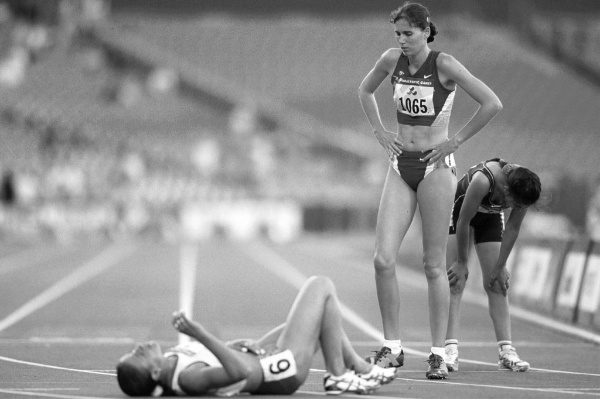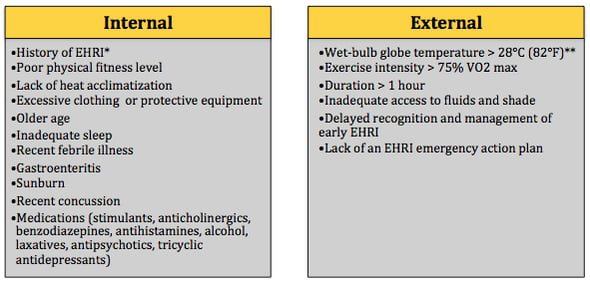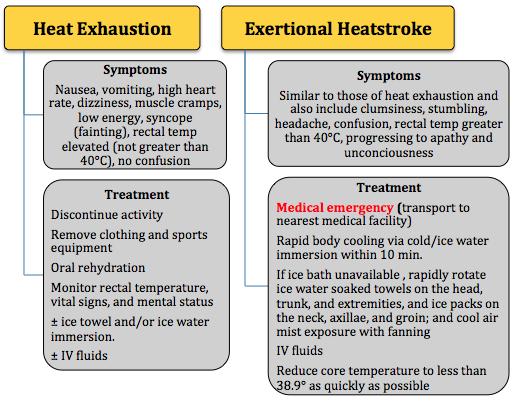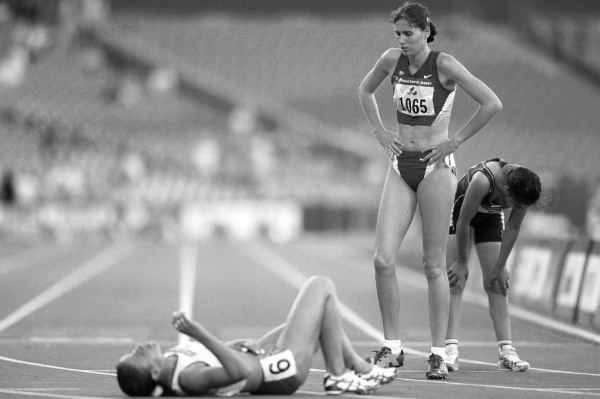Beat the Heat: Cooling Methods and Exertional Heat-Related Illness

Okay, so you’ve fully acclimated yourself to the heat and mastered your hydration plan. You’re almost ready to take on the blisteringly hot, swelteringly humid conditions of competition. A discussion on heat training would not be complete without addressing cooling methods and early identification of exertional heat-related illness.
Keep Your Cool
It may sound contradictory to state that an athlete should cool down during a warm-up, but some studies have shown that “pre-cooling” can reduce cardiovascular strain and improve both endurance and high-intensity, repeated sprint exercise performance in hot conditions.1-4 Other studies have shown less of a benefit in the shorter sprint distances and even a decrease in performance.5-6 For example, cooling the legs through cold water immersion prior to exercise can decrease nerve conduction and the speed of muscle contraction which would lead to decreased performance during sprints.7 As an alternative, the use of cooling garments which selectively cool the torso may decrease the core temperature and thus reduce cardiovascular strain without impairing leg performance, allowing a runner to maintain high performance.8
The ingestion of cold fluids or ice slurry beverages is a topic of debate, especially during exercise, with the main argument being that sweat rate is reduced leading to less skin surface evaporation.9 More recent studies have shown that ingestion of ice slurry beverages before or during endurance or intermittent-sprint exercise led to improved performance.10-13 One accepted theory is that the ingestion of ice slurry beverages delayed the time to reach a critically high, performance-impairing core temperature and also led to an increased ability for the body to store heat (i.e., a larger “heat sink”). This cooling method was found to have greater benefit over cold water ingestion because of the combined solid and liquid form as well as the energy attained from the “phase change” from solid to liquid.10 If the resources are available, it’s best to take a combined approach of ingesting ice slurry beverages, wearing cooling vests (if vests are not too heavy), and the use of a fanning system.14 Similar to hydration, cooling methods should be tested and individualized during training to minimize unwanted outcomes in performance during competition.
Exertional Heat-Related Illness
In warm summer conditions as athletes push their limits, the dangers of overheating are high, even for elite athletes. To properly conclude this discussion on heat training, I want to address the importance of early recognition of exertional heat related illness (EHRI). EHRI is a spectrum of heat illnesses that can occur during exercise in conditions of heat stress with high temperatures and sometimes high humidity levels.15 If potential for high environmental heat stress (high temperature and humidity, windless air, and extreme solar radiation) exists, athletes, coaches, and athletic trainers should be aware of internal and external risk factors for EHRI (Table 1) as well as early recognition and preventative strategies.
Table 1 – EHRI Risk Factors

* EHRI: Exertional heat-related illness
** Wet-bulb globe temperature is a measure of the heat stress in direct sunlight, which takes into account temperature, humidity, wind speed, sun angle and cloud cover (solar radiation).
EHRI usually starts with a heat rash or “prickly heat” (itchy rash over clothed areas) and heat edema (puffiness in gravity-dependent regions like the ankles).15 This can progress to exercise-associated collapse, which usually occurs after exercise has stopped when the leg muscles stop acting as a pump to bring blood back to the heart. If an athlete is prone to exercise-associated collapse, he or she may benefit from wearing compression sleeves or socks during training and especially on days of competition.16
Other indicators of EHRI include exercise-associated muscle cramps, which can be the result of excessive sweat losses or heavily worked muscles leading to over-excited nerves. Further discussion on management of EAMC can be found here.
Heat exhaustion is the most common form of EHRI and is seen in athletes who reach a dehydrated state leading to a drop in blood pressure. The most serious form of EHRI, exertional heat stroke, is one of the top causes for sudden death in athletes on-field, with American football, in which pre-season training spans the hottest summer months, having the greatest number of fatalities. Heat exhaustion and exertional heat stroke are compared in Table 2. Athletes who exhibit signs and symptoms of exertional heatstroke should be immediately removed from competition and taken to the nearest medical facility for rapid management. Exertional heat stroke is preventable when athletes do proper heat training leading up to competition, are mindful of environmental heat stresses, and recognize early signs and symptoms.
Table 2 - Heat Exhaustion vs Heat Stroke - the Risk Factors

Reaching an optimal performance state in challenging, hot, humid conditions is attainable if an athlete prepares properly, which includes factoring in time for adequate heat acclimatization, taking into consideration the specific variables that may be experienced during competition. Equally important is a sound hydration strategy, which is ideally practiced throughout training. Finally, understanding the role of re-cooling and recognizing early signs of exertional heat-related illness are some final key pieces in successful heat training. Executing the strategies detailed in this 3-part series will set you up for success in your next heated competition.
References
- Racinais S, Alonso J M, Coutts A J, Flouris A D, Girard O, González Alonso J, Hausswirth C, Jay O, Lee J K, Mitchell N, Nassis G P, Nybo L, Pluim B M, Roelands B, Sawka M N, Wingo J E, Périard J D. 2015. Consensus recommendations on training and competing in the heat. Scandinavian journal of medicine & science in sports 25 Suppl 1 : 6-19.
- Siegel R, Mate J, Watson G, Nosaka K, Laursen PB. Pre-cooling with ice slurry ingestion leads to similar run times to exhaustion in the heat as cold water immersion. J Sports Sci 2012: 30: 155–165.
- Marsh D, Sleivert G. Effect of precooling on high intensity cycling performance. Br J Sports Med 1999: 33: 393–397.
- Brade C, Dawson B, Wallman K. Effect of precooling and acclimation on repeat-sprint performance in heat. J Sports Sci 2013: 31: 779–786.
- Brade C, Dawson B, Wallman K. Effects of different precooling techniques on repeat sprint ability in team sport athletes. Eur J Sport Sci 2014: 14: S84–S91.
- Sleivert GG, Cotter JD, Roberts WS, Febbraio MA. The influence of whole-body vs torso pre-cooling on physiological strain and performance of high-intensity exercise in the heat. Comp Biochem Physiol 2001: 128: 657–666.
- Racinais S, Oksa J. Temperature and neuromuscular function. Scand J Med Sci Sports 2010: 20 (Suppl. 3): 1–18.
- Cheuvront SN, Kolka MA, Cadarette BS, Montain SJ, Sawka MN. Efficacy of intermittent, regional microclimatecooling. J Appl Physiol 2003: 94: 1841–1848.
- Bain AR, Lesperance NC, Jay O. Body heat storage during physical activity is lower with hot fluid ingestion under conditions that permit full evaporation. Acta Physiol (Oxf) 2012: 206: 98–108.
- Siegel R, Mate J, Brearley MB, Watson G, Nosaka K, Laursen PB. Ice slurry ingestion increases core temperature capacity and running time in the heat. Med Sci Sports Exerc 2010: 42: 717–725.
- Siegel R, Mate J, Watson G, Nosaka K, Laursen PB. Pre-cooling with ice slurry ingestion leads to similar run times to exhaustion in the heat as cold water immersion.
- Stevens CJ, Dascombe B, Boyko A, Sculley D, Callister R. Ice slurry ingestion during cycling improves Olympic distance triathlon performance in the heat. J Sports Sci 2013: 31:1271–1279
- Yeo ZW, Fan PW, Nio AQ, Byrne C, Lee JK. Ice slurry on outdoor running performance in heat. Int J Sports Med 2012: 33: 859–866.
- Bongers CC, Thijssen DH, Veltmeijer MT, Hopman MT, Eijsvogels TM. Precooling and percooling (cooling during exercise) both improve performance in the heat: a meta-analytical review. Br J Sports Med 2015: 49: 377–384.
- Nichols A W. 2014. Heat-related illness in sports and exercise. Current Reviews in Musculoskeletal Medicine 7 (4): 355-365.
- Privett SE, George KP, Whyte GP, Cable NT. The effectiveness of compression garments and lower limb exercise on post-exercise blood pressure regulation in orthostatically intolerant athletes. Clin J Sport Med. 2010;20:362–7.
Disclaimer: This blog is for informational purposes only. Doctors cannot provide a diagnosis or individual treatment advice via e-mail or online. Please consult your physician about your specific health care concerns.
About the Author

Dr. Emily Kraus is a BridgeAthletic performance team contributor where she focuses on topics that are at the forefront of athletics and medicine. She is the incoming Stanford non-operative sports medicine fellow in Physical Medicine and Rehabilitation. Emily has provided medical coverage for events such as the USATF National Track and Field Championships and is the research coordinator for a multi-center study focused on prevention of stress fractures in division I collegiate runners. Emily has finished six marathons, recently ran (and won) her first 50km trail ultramarathon, and placed 56th female in the 2016 Boston Marathon. Emily is passionate about injury prevention, running biomechanics, and the promotion of health and wellness.
Related Posts

The Best Bench Press Variation You’re...
This post is part of our Coaches Corner series with Taylor Rimmer. Taylor is NSCA-CPT, StrongFirst...

Does Powerlifting Harm Heart Health?
A recent study has discovered that a 12-week supervised strength training program (SSTP) may result...
-1.png)
Barefoot Running: Is It For You? |...
Run Free: Consider Less Cushion
Updated October 2020:
With more athletes looking for ways to...



